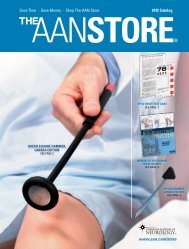weakness: practical guide for family physicians - American Academy ...
weakness: practical guide for family physicians - American Academy ...
weakness: practical guide for family physicians - American Academy ...
Create successful ePaper yourself
Turn your PDF publications into a flip-book with our unique Google optimized e-Paper software.
WEAKNESS: PRACTICAL GUIDE FOR FAMILY<br />
PHYSICIANS<br />
Raymond A. Martin, MD<br />
Houston Neurology Associates<br />
Houston, TX<br />
Jeffrey Rosenfeld, MD, PhD<br />
Carolinas Neuromuscular/ALS Center<br />
Charlotte, NC<br />
David Bauer, MD<br />
Memorial Family Practice Residency Program<br />
Houston, TX<br />
124
A common complaint of many patients in a primary care setting is “Doctor, I am weak."<br />
One could accept this outright as a manifestation of loss of strength in some muscle groups but a<br />
wiser approach is to ask the patient to specifically define what he or she means by <strong>weakness</strong>. The<br />
answer is often surprising and may encompass complaints as varied as fatigability, apathy, loss of<br />
sensation, imbalance or excessive drowsiness. If, indeed, the complaint is actual loss of strength<br />
in muscle groups, then an accurate history directed to causes of <strong>weakness</strong> must be obtained.<br />
In<strong>for</strong>mation important <strong>for</strong> the evaluation of <strong>weakness</strong> includes:<br />
The temporal profile of <strong>weakness</strong> onset<br />
Acute<br />
Subacute<br />
Chronic<br />
The distribution of the <strong>weakness</strong>:<br />
Proximal<br />
Distal<br />
Symmetric<br />
Asymmetric<br />
- Hemiparesis (one half of the body)<br />
- Paraparesis (lower extremities)<br />
- Monoparesis (one extremity)<br />
- Focal <strong>weakness</strong> (portion of an extremity or the face)<br />
Once the history is obtained the neurological examination should confirm the presence of<br />
any <strong>weakness</strong> as well as its distribution. Important associated findings are muscle atrophy, pain<br />
and tenderness, swelling, fasciculations (a visible twitch under the skin caused by the<br />
spontaneous firing of a motor unit [one anterior horn cell and all the muscle fibers it innervates]),<br />
deep tendon reflex changes and sensory loss.<br />
The following cases will illustrate different types of <strong>weakness</strong>, with their associated<br />
histories and physical findings.<br />
Case 1<br />
A 71-year-old male is eating breakfast and has abrupt onset of visual loss in the left eye and<br />
<strong>weakness</strong> in the right arm and leg. There is some tingling of the right hand and right corner of his<br />
mouth. He has difficulty standing and is taken to the emergency room where you are called to see<br />
him. On exam his vision has recovered but he has <strong>weakness</strong> of the right arm involving the<br />
triceps, wrist and finger extensors and the right leg involving the hamstrings (lower leg flexors)<br />
and anterior tibial (foot dorsiflexors). The deep tendon reflexes are more brisk on the right, and<br />
he has a right Babinski sign. Sensory exam reveals decreased sensation in the right hand and arm,<br />
and less on the right the face and leg. He has difficulty identifying objects placed in his hand by<br />
sensation alone. The patient has no difficulty understanding speech, but speaks infrequently and<br />
with a paucity of otherwise meaningful words<br />
125
General physical examination reveals a left carotid bruit and a normal sinus rhythm.<br />
Analysis. The patient is elderly and had abrupt onset of <strong>weakness</strong> (acute), with a<br />
distribution best classified as a hemiparesis. Associated symptoms are ipsilateral sensory loss and<br />
contrateral monocular blindness. The acute onset suggests a vascular etiology and the clinical<br />
findings best fit the brain location supplied by the left internal carotid artery.<br />
The first branch of the left internal carotid artery is the ophthalmic artery (OA).<br />
Decreased blood flow in this artery would produce transient monocular visual loss, known as<br />
amaurosis fugax (fleeting blindness). The patient usually experiences this as a curtain being<br />
pulled down over the eye, lasting several minutes, then clearing. The retina often recovers due to<br />
collateral circulation from the external carotid artery (ECA), and vision returns.<br />
The carotid artery then divides into the middle and anterior cerebral artery. The middle<br />
cerebral artery (MCA) supplies the lateral hemisphere (see homunculus, Chapter 1, Figure 2.22).<br />
The prefrontal motor area supplied by the MCA encompasses the face, hand, upper extremity and<br />
trunk. The motor cortex supplied by the anterior cerebral artery (ACA), encompasses the leg. The<br />
MCA and ACA supply analogous sensory areas (parietal).<br />
The best diagnosis is stroke in the distribution of the left internal carotid artery (ICA), due<br />
to involvement of the ophthalmic, middle and anterior cerebral arteries. Another clue on<br />
examination is the left carotid bruit. Bruits are due to turbulent blood flow, which can in turn be<br />
caused by vessel stenosis. When a vessel completely occludes, the bruit disappears. .<br />
Summary. Abrupt onset (vascular) of left visual loss (left OA) and right hemiparesis<br />
(MCA and ACA = ICA ) is suggestive of a stroke in the left internal carotid artery distribution.<br />
This could be embolic or thrombotic in etiology.<br />
126
Table 1: Characteristics of upper motor neuron <strong>weakness</strong><br />
Distribution Lower face,<br />
Extensor muscles in the arm<br />
Flexor muscles in the leg<br />
Muscle Tone Spasticity,<br />
Increased resistance overcoming flexion in the arm and overcoming<br />
extension in the leg (Like opening a clasped knife)<br />
Reflexes Deep tendon reflexes are increased and clonus may be elicited<br />
Pathological Clonus at the patella or ankle<br />
Reflexes<br />
Babinski sign in the lower extremity<br />
Atrophy Does not occur with UMN <strong>weakness</strong><br />
Mild disuse atrophy may be seen<br />
Coordination There is slowness or incoordination of fine motor movements, eg,<br />
tapping fingers or wiggling toes<br />
Case 2<br />
A 33-year-old male construction worker has been in good health except <strong>for</strong> a recent bout of<br />
gastroenteritis. Initially he noted some paresthesias in his feet and less so in his fingers. The<br />
following day he noted difficulty climbing a ladder. He presented to the Emergency Department<br />
and was noted to have hypoactive deep tendon reflexes, no sensory loss and was able to walk<br />
unassisted. A diagnosis of “flu” was given and he was given symptomatic treatment. He spent the<br />
remainder of the day resting in bed. The following morning he fell while attempting to walk to<br />
his bathroom and at that time, was unable to stand without support. Re-evaluation, at the<br />
Emergency Department, revealed distal leg <strong>weakness</strong> and absent deep tendon reflexes. There was<br />
no objective sensory deficit.<br />
Other studies included normal EKG, CPK and troponin and normal chest x-ray.<br />
Neurology consultation was obtained. Nerve conduction/EMG studies revealed prolonged distal<br />
motor latencies and slowed nerve conduction velocities. CSF was obtained and showed a protein<br />
level of 80 mg/dl with no cells and normal glucose. Treatment was started.<br />
The following day the patient noted some difficulty grasping and elevating his arms but<br />
then stabilized. After one week of treatment strength started to return in the upper, then lower<br />
extremities.<br />
Discussion. This individual had a subacute process causing progressive <strong>weakness</strong> that<br />
started distally and progressed proximally over days, ultimately affecting the patient’s ability to<br />
walk. Over time, the deep tendon reflexes disappeared, suggesting a lower motor neuron or<br />
peripheral nerve lesion. Associated findings are elevated CSF protein with a normal cell count<br />
(albumino-cytologic dissociation) and slowed motor nerve conduction velocities (demyelination).<br />
The disorder that is most likely to produce this profile is acute inflammatory demyelinating<br />
polyradiculoneuropathy (AIDP) also known as Guillain-Barré syndrome.<br />
127
Current treatment involves alternate day plasmapheresis or daily administration of<br />
intravenous immune globulin (IVIG). These treatments have significantly improved the<br />
outcome of patients with this immune mediated disorder.<br />
Failure to provide timely treatment could lead to progressive <strong>weakness</strong>, and respiratory<br />
failure, with need <strong>for</strong> assisted ventilation. Prolonged disease duration could also produce axonal<br />
nerve damage with subsequent prolonged recovery times, muscle atrophy, contractures and motor<br />
disability. With severe untreated disease autonomic involvement could lead to hypo- or<br />
hypertension and life threatening cardiac arrhythmias.<br />
Table 2: Characteristics of lower motor neuron <strong>weakness</strong><br />
Distribution Peripheral neuropathy, distal and<br />
symmetrical; or, follows the distribution of<br />
root, plexus or peripheral nerve<br />
Muscle Tone Decreased in the affected muscles<br />
Reflexes Decreased or absent<br />
Atrophy Present in the affected muscles<br />
Fasciculations may be noted<br />
Coordination There is motor ataxia proportional to the<br />
degree of <strong>weakness</strong><br />
Case 3<br />
A 68-year-old male was diagnosed with prostate cancer two years earlier. His biopsy showed an<br />
undifferentiated carcinoma and he was treated with surgical excision and local radiation therapy.<br />
Several months later chemotherapy was started because of rising prostatic alkaline phosphatase<br />
and prostate specific antigen (PSA) levels. Three months later he noted increasing leg fatigue<br />
when he went <strong>for</strong> his daily walk. Two weeks later he fell while walking his dog but sustained no<br />
injuries. There were several subsequent falls followed by increasing complaints of low thoracic<br />
mid back pain. Finally one fall caused a right proximal humerus fracture and he was admitted to<br />
the hospital. Initial evaluation revealed mild to moderate proximal bilateral leg <strong>weakness</strong> and he<br />
was kept on bed rest. Spine x-rays revealed anterior compression fractures at several levels in the<br />
upper lumbar, lower and mid thoracic spine. A technetium bone scan showed uptake in the spine<br />
corresponding to the fracture sites and other areas.<br />
Difficulty initiating urination and occasional small volume incontinence prompted<br />
insertion of an indwelling Foley catheter. On insertion the initial volume drained was 800 cc.<br />
Physical therapy was ordered but discontinued on day 2 because of lack of cooperation.<br />
Oncology consultation was requested.<br />
128
On day 4 after admission, nursing service in<strong>for</strong>med the admitting physician that the<br />
patient could no longer move his legs to cooperate with bathing. Repeat examination disclosed<br />
that the patient had flaccid paraplegia of both lower extremities. Neurological consultation<br />
confirmed flaccid lower extremity paraplegia, a sensory level at T-10 and diminished rectal<br />
sphincter tone. Beevor’s sign, was present (upward motion of the umbilicus with neck flexion<br />
while lying supine, caused by <strong>weakness</strong> of abdominal muscles below T-10).<br />
An emergency MRI scan showed some lysis of the T-10 vertebral body with a posterior<br />
tumor mass compressing the conus medullaris and distal spinal cord. Emergency radiation<br />
therapy to the area was started. Six months later the patient had some return of antigravity leg<br />
movement, but was unable to ambulate independently.<br />
Discussion. The above case illustrates how spinal cord lesions can progress, subacutely,<br />
to full paraplegia even when the patient is in a setting where he/she is observed. Once the patient<br />
is on bed rest, progressive leg <strong>weakness</strong> is harder to detect, by medical staff or the patient.<br />
Numerous early warning signs could have alerted the physician to the presence of an early<br />
myelopathy in this patient:<br />
Multiple spine compression fractures; and an abnormal bone scan with a known<br />
malignancy (prostate carcinoma), that is known <strong>for</strong> bone metastasis.<br />
Increased frequency of falls most likely due to progressive leg <strong>weakness</strong>.<br />
Development of spine pain as part of the current symptomatology, secondary to<br />
metastases and compression fractures.<br />
Overflow urinary incontinence, with a large residual volume on catheterization, due to<br />
evolving <strong>weakness</strong> of the bladder detrusor muscles secondary to sacral outflow<br />
interruption.<br />
Daily neurological examination would to have led to earlier detection of evolving leg<br />
<strong>weakness</strong>, a rising sensory level, and the development of lower abdominal wall <strong>weakness</strong><br />
(Beevor’s sign). The <strong>weakness</strong> would have had the characteristic upper motor neuron<br />
distribution with extensor muscle groups being stronger than the corresponding flexors.<br />
(Gluteus maximus stronger than iliopsoas, quadriceps stronger than hamstrings and<br />
gastocnemius stronger than anterior tibial, posterior tibial stronger than peronei. It is<br />
this distribution of <strong>weakness</strong> that produces the classic leg posture in upper motor neuron<br />
<strong>weakness</strong>; leg extended at the hip and knee with the foot pointed down and inverted).<br />
The importance of this case lies in the fact that, once paraplegia develops, and lasts <strong>for</strong> up<br />
to 24 hours, surgical or radiation intervention may not be as beneficial in terms of restoration of<br />
normal neurological function. Any spinal cord lesion, once suspected should be monitored<br />
closely <strong>for</strong> progression, while the work-up proceeds to determine the cause, and thus the<br />
treatment of the pathological process.<br />
129
This particular patient had spinal metastases that produced spinal cord compression with<br />
clinical signs that evolved in a subacute fashion. Spinal cord metastases frequently involve the T-<br />
10 region because a main arterial feeder; the artery of Adamkewicz, arises around the L1 level<br />
and supplies the distal spinal cord. The practitioner must beware of ordering just a “lumbar” MRI<br />
scan or “lumbar” myelogram on a patient with evolving leg <strong>weakness</strong>. This study, as ordered,<br />
will visualize the spine up to T12-L1 and potentially miss lower thoracic spine lesions.<br />
A key clinical pearl is always to suspect an evolving spinal cord lesion in a patient<br />
with spine pain, progressive leg <strong>weakness</strong>, and urinary incontinence or retention. The<br />
presence of the above clinical findings in a known cancer patient should be particularly alarming,<br />
especially primary cancer of the prostate, breast, colon, and kidney. Another malignancy that<br />
commonly causes spine involvement is multiple myeloma.<br />
Early recognition can lead to prompt treatment, which will prolong survival and hopefully<br />
preserve the ability to walk and maintain bladder control.<br />
Table 3. Characteristics of spinal cord lesions<br />
Intrinsic Extrinsic<br />
Weakness Upper motor neuron; below Upper motor neuron; below<br />
level of cord involvement level of cord involvement.<br />
Sensory Sensory dissociation (Some<br />
pathways severely affected,<br />
others are normal<br />
130<br />
All modalities affected,<br />
fairly equally. May have<br />
Brown-Séquard distribution<br />
(Chapter 1)<br />
Pain Usually none Root pain at the level of<br />
compression<br />
Root lesion No Yes<br />
Reflexes Brisk below level of lesion Decreased at level of lesion<br />
(root) and increased below<br />
Example Multiple Sclerosis Tumor, Disc<br />
Case 4<br />
A 23-year-old female, first noted difficulty exercising on the stair-climber at her local health spa.<br />
She had been in top physical condition, engaging in daily aerobic workouts <strong>for</strong> the past 18<br />
months. Her first symptoms were a feeling of heaviness in her legs after stair climbing <strong>for</strong> about<br />
15 minutes. As she continued, the <strong>weakness</strong> would worsen. She sought the advice of her personal<br />
trainer who thought she should vary her routine and exercise her upper body more. She changed<br />
her routine so that once she tired on the stair climber she would switch to the rowing machine.<br />
This seemed to solve the problem <strong>for</strong> the next several weeks.
Over the ensuing weeks she noted increasing fatigue and actual <strong>weakness</strong> as she<br />
continued her workouts. Variation in her program and new routines seemed to give very transient<br />
relief. She stopped her exercise program on the advice of a friend and noted that she<br />
symptomatically improved. Things went along well <strong>for</strong> another few weeks as she substituted<br />
reading <strong>for</strong> exercise in her leisure hours. A visit to her physician was finally prompted by some<br />
new episodes consisting of diplopia and ptosis after about an hour of reading. She noted<br />
improvement when she rested, only to have the diplopia recur when she began reading again.<br />
Examination by her primary care physician noted her to be in good health otherwise. Her<br />
peripheral strength appeared normal. Her reflexes were on the brisk side but normal and there<br />
were no sensory deficits. Coordination and cranial nerve examination was normal.<br />
Laboratory studies revealed normal CBC, chemistry profile, sedimentation rate, ANA,<br />
thyroid function studies, CPK, urinalysis and RPR. Chest x-ray, and EKG. Pulmonary function<br />
studies were also normal.<br />
She was referred <strong>for</strong> neurological consultation. Physical findings confirmed that the<br />
patient demonstrated <strong>weakness</strong> with sustained muscle activity. If she held her gaze upward, after<br />
two minutes some ptosis was noted in the right and then left eye. With sustained upward gaze she<br />
reported vertical diplopia. In a similar fashion she had difficulty doing deep knee bends after 8<br />
repetitions and then could not stand upright without assistance. After a brief period of rest the<br />
<strong>weakness</strong> resolved, only to recur with repeated exercise.<br />
Exercise was then repeated to demonstrate observable ptosis, dysconjugate gaze and<br />
inability to stand up from a squatting position. At this point the patient was given 5 mg of<br />
edrophonium chloride (Tensilon ® ) intravenously, after a 1 mg test dose. This led to immediate<br />
resolution of <strong>weakness</strong> <strong>for</strong> several minutes.<br />
A repetitive nerve stimulation test demonstrated a neuromuscular transmission defect and<br />
a blood test revealed a high titer of antibodies directed against acetylcholine receptor antigen.<br />
(ACh receptor Ag).<br />
By now you have surmised that the patient has myasthenia gravis (MG), an autoimmune<br />
disease. The hallmark of this disease process is the development of muscle <strong>weakness</strong> with<br />
exercise. Patients are usually stronger in the mornings and after rest, and weaker after exercise<br />
and later in the day. The distribution of <strong>weakness</strong> can be ocular (ptosis and diplopia), bulbar<br />
(dysarthria, dysphagia), or generalized, (extremity <strong>weakness</strong> and difficulty breathing).<br />
The diagnosis depends on demonstrating a defect in neuromuscular transmission by:<br />
Specialized nerve conduction studies such as repetitive stimulation and single fiber EMG.<br />
Transiently overcoming the neuromuscular blockage using edrophonium chloride, which<br />
is an acetylcholinesterase inhibitor.<br />
Demonstrating antibody directed against the ACh receptor antigen.<br />
131
Treatment of MG consists of two major components:<br />
Symptomatic: Varying doses of pyridostigmine (Mestinon ® ), at 4-6 hour intervals provide<br />
improvement in muscle fatigability. This drug is a long acting acetylcholinesterase inhibitor.<br />
Immunosuppression:<br />
Prednisone initiated in small alternate day doses (12.5 mg) and slowly increased by 12.5 mg<br />
every other dose. Full benefit is usually obtained at doses of 60 to 100 mg every other day.<br />
Once improvement is achieved the dosage can be gradually reduced to the smallest one that<br />
maintains benefit.<br />
Azothiaprine may be a better agent if long-term use is contemplated due to fewer overall side<br />
effects than steroids. However, the potential toxic effect on bone marrow and liver function<br />
must be carefully monitored. Long-term use on a young patient may increase the risk of<br />
oncogenesis.<br />
Plasmapheresis will provide short-term improvement in function by lowering antibody titer.<br />
It is a useful modality to prepare myasthenic patients <strong>for</strong> surgery (thymectomy) or as an<br />
adjunctive treatment in myasthenic crisis (situations of disease worsening when patients may<br />
be unable to swallow or breathe adequately without assistance).<br />
IVIg is a newer <strong>for</strong>m of therapy that may have fewer risks than plasmapheresis, eg, central<br />
venous catheter infection or thrombosis, but is expensive. IVIg is currently achieving wider<br />
use in treating patients with MG that is more difficult to control with conventional therapy.<br />
IVIg has a duration of action that may last several weeks and sometimes several months in<br />
patients being treated with other immunosuppressive drugs. It is easier to administer than<br />
plasmapheresis especially in patients with poor venous access. Potential risks in adults with<br />
other health problems are congestive heart failure, acute renal failure and deep vein<br />
thrombosis.<br />
Thymectomy may be a curative procedure. The thymus gland appears to have a major role in<br />
promulgating this disease process and removal may lead to disease remission in a significant<br />
number of patients. The patient should be at maximal functional capacity prior to surgery.<br />
This may require pretreatment with steroids and plasmapheresis. The thymus should be<br />
removed with a sternal splitting procedure and not through mediastinoscopy. Any remaining<br />
thymus tissue may interfere with attainment of remission and mediastinoscope procedures<br />
may miss rests of thymic tissues located deep in the mediastinal gutters.<br />
Finally, the thymus gland should be evaluated in all patients diagnosed with myasthenia gravis.<br />
Typically, it is hypertrophied. However, about 15% of myasthenic patients have a malignant<br />
thymoma, which can be locally invasive and requires surgical as well as radiation therapy. MG in<br />
this setting is more difficult to treat and these myasthenics appear to be more resistant to<br />
conventional therapy.<br />
132
Table 4. Characteristics of <strong>weakness</strong> in myasthenia gravis<br />
Distribution Cranial nerves: diplopia, dysphagia,<br />
dysarthria<br />
Proximal or distal, usually symmetric<br />
Reflexes Normal or increased<br />
Muscle tone Normal<br />
Coordination Affected in proportion to degree and<br />
distribution of <strong>weakness</strong><br />
Unique features Weakness increases with exercise and<br />
improves with rest<br />
Case 5<br />
A 28-year-old construction worker was injured on the job, twisting his back to the right. He<br />
initially complained of soreness but was able to continue working the remainder of the day if he<br />
avoided lifting. The following morning he noted increased low back pain, which radiated down<br />
the posterior aspect of his left leg. There was also paresthesia in the left first toe.<br />
He reported the injury and was sent to the company physician who ordered plain LS spine<br />
x-rays. These showed some loss of the L4-5 disc height but were otherwise normal. Light duty,<br />
NSAIDs and muscle relaxants were prescribed, but to no avail. His symptoms were particularly<br />
bad at night, although sleeping in a reclining chair with his knees and back flexed helped.<br />
He remained off work and attended physical therapy daily <strong>for</strong> the next three weeks. He<br />
noted no further improvement and towards the end of the three-week period noted he had to<br />
purposefully lift his left leg higher to prevent the toes from scraping the ground when he walked.<br />
Neurological examination at this time, revealed pain with straight leg raising at 50<br />
degrees on the left and 80 degrees on the right. He was unable to heel walk on the left and there<br />
was specific <strong>weakness</strong> of the left anterior tibial, posterior tibial, peronei and toe extensor<br />
muscles. The left internal hamstring reflex was reduced and there was vague subjective sensory<br />
loss over the dorsum of the left foot.<br />
This history and associated clinical findings strongly suggest the subacute development of<br />
a left L-5 radiculopathy. In this setting the most likely diagnosis is a herniated intervertebral disc,<br />
which could be demonstrated on MRI. Had the onset been acute, in a known diabetic with a<br />
negative MRI scan, consideration to nerve root infarction should be given. Chronic onset of<br />
similar symptoms in a patient with multiple myeloma or prostate cancer should make one<br />
investigate metastatic disease as a likely possibility.<br />
He reported back pain radiating down the posterior leg, now with paresthesias on the sole<br />
of the foot, <strong>weakness</strong> with toe walking, and a diminished Achilles tendon reflex, makes S1<br />
radiculopathy the underlying cause. Pain in the neck, which radiates to an upper extremity, is<br />
often due to cervical radiculopathy. The most common roots affected are C7 and C6. C7 root<br />
lesions are associated with pain, paresthesias in the middle fingers, <strong>weakness</strong> usually of the<br />
133
triceps, pronator teres and finger extensors. There is usually a diminished triceps reflex. C6<br />
<strong>weakness</strong> involves the biceps, deltoid, brachioradialis and pronator teres, with associated<br />
paresthesias in the index finger and a diminished biceps and brachioradialis reflex.<br />
If <strong>weakness</strong> is present with any radiculopathy, an imaging study should be done to<br />
identify the underlying cause. With cervical spondylosis or herniated disc, immobilization with a<br />
soft cervical collar <strong>for</strong> one to two weeks may be curative.<br />
With lumbar radiculopathy, associated with <strong>weakness</strong>, conservative measures may be less<br />
successful and surgery may be indicated. Needless to say, if he patient has <strong>weakness</strong>, he should<br />
be monitored closely <strong>for</strong> progression while undergoing conservative management. If <strong>weakness</strong> is<br />
progressive during therapy, and a surgical lesion is responsible, neurosurgical consultation<br />
should be obtained.<br />
Table 5. Characteristics of nerve root <strong>weakness</strong><br />
Symptoms Pain in a radicular distribution<br />
Paresthesias in the sensory distribution on<br />
the affected nerve root<br />
Aggravated by activities that lengthen the<br />
involved nerve root, eg, straight leg raising.<br />
Weakness in the distribution of the<br />
involved nerve root.<br />
Distribution Cervical: upper extremity<br />
Thoracic: chest or abdominal wall<br />
Lumbar: lower extremity<br />
Muscle Tone Decreased in the affected muscles<br />
Reflexes Decreased or absent in the affected<br />
dermatome or myotome<br />
Atrophy Present in the affected muscles<br />
Fasciculations may be noted<br />
Coordination Usually unaffected<br />
134
Case 6<br />
A 45-year-old male had been working late at home doing accounting deskwork. He had been to a<br />
social affair earlier and had consumed some alcohol. To unwind he had another drink while<br />
working. He next recalls awakening in a leaned back position in his rigid-back wooden chair. He<br />
noted an aching pain in his right triceps area. He cleared his head and then attempted pick up his<br />
pen. He noted he could not open his right hand or elevate his wrist and the dorsal surface of the<br />
hand was tingling. He assumed he was having a stroke and had his wife take him to the nearest<br />
Emergency Room. Examination there revealed right fingers and wrist extensor <strong>weakness</strong> and a<br />
diminished right brachioradialis reflex. There was vague subjective sensory loss on the dorsal<br />
hand, but no other findings. A CT scan of the head was obtained which was normal. Routine<br />
laboratory studies were normal and the patient was normotensive. There were no other stroke risk<br />
factors, and a chest x-ray and EKG were normal. The local neurologist was consulted to<br />
determine if the patient was a candidate <strong>for</strong> treatment with tissue plasminogen activator (tPA).<br />
The neurologist evaluated the patient and decided the <strong>weakness</strong> was fairly acute in onset<br />
and had occurred during sleep. The <strong>weakness</strong>, as previously described, involved wrist and finger<br />
extensors, with dorsal hand sensory loss and a diminished brachioradialis reflex. He concluded<br />
that the problem was an acute radial neuropathy, caused by prolonged pressure of the nerve at a<br />
vulnerable point (the radial groove of the humerus), while the patient slept. He told the patient to<br />
wear a neutral wrist splint to prevent a flexion contracture and to follow up in the ambulatory<br />
clinic. If the <strong>weakness</strong> persisted beyond three weeks, nerve conduction and EMG studies were<br />
planned.<br />
This case illustrates that some cases of acute onset <strong>weakness</strong> can have etiologies other<br />
than stroke. The history and examination help establish the correct diagnosis. Inappropriate<br />
administration of tPA, in the above case, may have led to unnecessary complications.<br />
Fortunately, the patient would have been excluded from tPA treatment since the exact time of<br />
onset of <strong>weakness</strong> was not known.<br />
Other peripheral nerve syndromes that may have acute or subacute onset include:<br />
Peroneal neuropathy or “crossed leg palsy”: In this condition there is inability to dorsiflex<br />
the foot and the person lifts the involved leg higher to enable the foot to clear the ground.<br />
Weakness is noted in the anterior tibial, peronei and toe extensor muscles. The posterior<br />
tibial muscle is spared and the deep tendon reflexes are normal. Usually the superficial<br />
peroneal nerve is spared and only mild sensory loss is noted in the webspace between the<br />
first and second toe. The condition is usually caused by pressure on the peroneal nerve as<br />
it goes across the fibular head. This is most frequently caused by crossing of the legs<br />
while sitting and is also called “crossed leg palsy”. Treatment is discontinuation of leg<br />
crossing or other activity that puts pressure on the peroneal nerve. Recovery develops<br />
over a few weeks if the lesion is only demyelinating.<br />
Ulnar neuropathy: This is one of the most common compression neuropathies. Normally<br />
the ulnar nerve is protected at the elbow because it lies in the ulnar groove. The olecranon<br />
usually rests on a hard surface when the elbow is leaned on, thereby protecting the ulnar<br />
135
nerve. As one ages the ulnar groove may become shallower, which exposes the ulnar<br />
nerve. Common activities involving leaning on the elbows, may now compress the ulnar<br />
nerve leading to the following symptoms:<br />
Numbness and sensory loss involving the fifth and lateral half of the fourth finger and<br />
medial portion of the palm on the affected hand.<br />
Weakness of the interossei and fourth and fifth lumbrical muscles (claw hand de<strong>for</strong>mity).<br />
Atrophy of the involved muscles.<br />
Tinel’s sign may be present at the ulnar groove.<br />
See Table 2 <strong>for</strong> characteristics of lower motor neuron <strong>weakness</strong>.<br />
Case 7<br />
A 46-year-old female stock clerk noted increasing pain in her shoulders and thighs at the end of<br />
the workday. She was somewhat better in the mornings but worsened at work. Her workload had<br />
not changed and she had no work related injuries. She also noted difficulty elevating stock boxes<br />
to shelves above shoulder level and some difficulty stepping up onto high plat<strong>for</strong>ms. The pain<br />
and <strong>weakness</strong> slowly worsened and within six months she had difficulty keeping her arms up<br />
when setting her hair, climbing stairs at home, and getting out of the bathtub.<br />
She sought medical attention and was initially diagnosed as having myalgia and<br />
musculoskeletal pain related to her job. She was treated with muscle relaxants and NSAIDs with<br />
only minimal relief of symptoms.<br />
A second visit to her physician revealed some difficulty getting out of a chair. Laboratory<br />
values showed mildly elevated transaminases and a CPK of 12,000 U/L, which fractionated to<br />
predominantly MM bands. Neurological consultation was requested.<br />
On neurological examination she was found to have symmetric <strong>weakness</strong> of the neck<br />
flexors, shoulder and hip girdle muscles. She had difficulty getting out of a low chair and in<br />
attempting to get up from a prone position, she had to extend her trunk by pushing upward with<br />
her hands on her thighs or using furniture to pull her trunk erect with her arms (Gower's Sign).<br />
This type of <strong>weakness</strong> is illustrative of myopathy, which may have many causes. A<br />
common acquired <strong>for</strong>m is polymyositis, an autoimmune inflammatory disorder. Metabolic<br />
myopathies can be due to hypothyroidism or Cushing’s disease among others. Congenital<br />
dystrophies can also present with proximal muscle <strong>weakness</strong>.<br />
136
Once suspected, diagnosis is confirmed with NC/EMG studies and muscle biopsy. A<br />
muscle biopsy should only be per<strong>for</strong>med and interpreted by someone with sufficient training and<br />
experience. A routine muscle biopsy, ie, a sample of any muscle is placed in <strong>for</strong>malin and then<br />
sent to the pathology laboratory, is not sufficient. Formalin actually distorts muscle architecture,<br />
so the specimen must be frozen in liquid nitrogen be<strong>for</strong>e being processed. Normal values have<br />
been ascertained <strong>for</strong> only a few muscles such as the biceps and quadriceps femoris. This<br />
in<strong>for</strong>mation should be obtained from the myologist be<strong>for</strong>e a muscle is selected <strong>for</strong> biopsy.<br />
Special staining and architecture measurement techniques per<strong>for</strong>med by the myologist give<br />
useful in<strong>for</strong>mation about the etiology of the myopathy.<br />
Accurate diagnosis depends on <strong>family</strong> history, laboratory evaluation, muscle biopsy and<br />
sometimes, genetic studies. Consultation with a specialist familiar with these disorders is<br />
frequently required. Treatment is directed to the underlying etiology.<br />
Table 6. Characteristics of myopathic <strong>weakness</strong><br />
Distribution Proximal: involves neck flexors, shoulder<br />
and hip girdle muscles<br />
Symptoms Problems climbing stairs, stepping up onto<br />
high steps, getting out of low places such as<br />
deep chairs, and holding arms over head <strong>for</strong><br />
prolonged periods<br />
Pain, tenderness, and sometimes swelling of<br />
involved muscles<br />
Muscle Tone Normal or diminished<br />
Severe <strong>weakness</strong> and contractures may<br />
develop<br />
Reflexes Normal or diminished in proportion to<br />
<strong>weakness</strong><br />
Atrophy Present with moderate to severe<br />
involvement<br />
Summary. The preceding cases represent some of the more common presentations of<br />
<strong>weakness</strong> including some that require urgent treatment intervention. When evaluating <strong>weakness</strong>,<br />
important considerations are the temporal profile, distribution of <strong>weakness</strong>, historical progression<br />
of the <strong>weakness</strong>, and associated symptoms such as pain and sensory changes. A thorough clinical<br />
examination to determine whether the <strong>weakness</strong> involves the upper or lower motor neuron, the<br />
neuromuscular junction or muscle itself, is mandatory. Once the above features are categorized,<br />
one can then establish a differential diagnosis and proceed with a proper workup designed to<br />
establish the correct clinical diagnosis. The appropriate treatment can then be chosen.<br />
137
Psychological Impact<br />
Although <strong>weakness</strong> may be a sign of a serious neurological condition, many patients with<br />
no neurological disorder present with a complaint of <strong>weakness</strong>. As noted in the introduction to<br />
this chapter, “<strong>weakness</strong>” doesn’t always mean a true loss of motor function. Patients who are<br />
depressed often complain of <strong>weakness</strong>. Hypothyroidism may present this way. Thus, it is critical<br />
that the physician considers not only the patient’s description of the problem and the physical<br />
examination, but also the context in which the patient presents.<br />
Patients have a great fear of loss of neurological function. The resulting loss of control,<br />
independence, and dignity is often more frightening to patients than cancer or myocardial<br />
infarction. It is critical that the physician be willing and able to address these fears. Many of the<br />
conditions discussed in the chapter will lead to permanent and even progressive disability. The<br />
physician must strike a balance between truthfully sharing in<strong>for</strong>mation and taking away all hope.<br />
In most cases, some positive in<strong>for</strong>mation can be provided. For example, it may be com<strong>for</strong>ting<br />
<strong>for</strong> a stroke patient to know that many similar patients do recover some or all of their function<br />
over time. Remember, also, that the shock of a new diagnosis may make it difficult <strong>for</strong> the<br />
patient and <strong>family</strong> to fully absorb your in<strong>for</strong>mation. Be prepared to repeat and elaborate it over<br />
time.<br />
Community Resources<br />
Ongoing needs will vary tremendously from patient to patient. For example, the patient<br />
with a large CVA may require skilled care in an extended care facility, while patients with small<br />
strokes may recover complete function. Most patients, though, benefit from various community<br />
resources. Home health services are a wonderful way to allow patients to remain in their home,<br />
at the same time receiving needed therapy. Physical therapy, speech therapy, and occupational<br />
therapy can all be given in the home, as well as in acute and extended care facilities. Family<br />
members can often be taught to provide these services. A growing array of supportive devices<br />
exists <strong>for</strong> helping patients compensate <strong>for</strong> their disabilities. Some “low tech” examples include<br />
eating utensils that can be strapped to the hand, splints, bathroom rails and elevated toilet seats.<br />
Sophisticated technology also comes into play, including motorized wheelchairs and scooters,<br />
seat lifters, symbol keyboards, text-to-speech systems, and speech recognition devices.<br />
National organizations <strong>for</strong> specific conditions offer a number of services, including<br />
literature directed to the lay audience, lists of local support groups, and treatment advances.<br />
National Stroke Association<br />
96 Inverness Drive East, Suite I<br />
Englewood, Colorado 80112-5112<br />
800-787-6537<br />
Website: http://www.stroke.org<br />
138
<strong>American</strong> Heart Association<br />
National Center<br />
7272 Greenville Avenue<br />
Dallas, Texas 75231<br />
800-242-8721<br />
Website: http://www.amhrt.org/catalog/Stroke_catpage30.html<br />
The ALS Association National Office<br />
27001 Agoura Road, Suite 150<br />
Calabasas Hills, Cali<strong>for</strong>nia 91301-5104<br />
800-782-4747<br />
Website: http://www.alsa.org<br />
Email: alsinfo@alsa-national.org<br />
Myasthenia Gravis Foundation of America<br />
123 W. Madison Street, Suite 800<br />
Chicago, IL 60602<br />
800-541-5454<br />
Website: http://www.myasthenia.org<br />
E-Mail: myasthenia@myasthenia.org<br />
The Neuropathy Association<br />
PO Box 2055<br />
Lenox Hill Station<br />
New York, NY 10021<br />
800-247-6968<br />
Website: http://www.neuropathy.org<br />
Email: info@neuropathy.org<br />
139
Self-Assessment<br />
1. All of the following clinical findings are important to determine the etiology of muscle<br />
<strong>weakness</strong> EXCEPT:<br />
A. distribution of <strong>weakness</strong><br />
B. presence of atrophy<br />
C. muscle tone<br />
D. deep tendon reflexes<br />
E. absence of muscle tenderness<br />
2. A feature of upper motor neuron <strong>weakness</strong> is:<br />
A. muscle atrophy<br />
B. fasciculations<br />
C. fibrillations<br />
D. diminished muscle tone<br />
E. increased deep tendon reflexes<br />
3. In <strong>weakness</strong> due to motor peripheral neuropathy, all of the following are true EXCEPT:<br />
A. the <strong>weakness</strong> is symmetric<br />
B. the <strong>weakness</strong> is distal.<br />
C. the <strong>weakness</strong> is proximal<br />
D. the <strong>weakness</strong> is usually greater in the lower extremities<br />
E. there may be associated muscle atrophy<br />
4. Upper motor neuron <strong>weakness</strong> from a cortical lesion has the following distribution:<br />
A. upper, flexors; lower, flexors<br />
B. upper, extensors; lower, flexors<br />
C. upper, flexors; lower, extensors<br />
D. upper, extensors; lower, extensors<br />
5. Progressive <strong>weakness</strong> in the lower extremities associated with back pain and urinary<br />
retention can be seen with:<br />
A. myelopathy secondary to a herniated thoracic disc.<br />
B. myasthenia gravis<br />
C. acute stroke<br />
D. inflammatory myopathy.<br />
E. all of the above<br />
6. Acute or subacute onset of cervical pain with radiation to an upper extremity may be<br />
caused by:<br />
A. herniated cervical disc<br />
B. spondylosis of the cervical spine<br />
C. Herpes zoster<br />
D. nerve root infarction secondary to diabetes<br />
E. all of the above<br />
140
7. Clinical findings associated with inflammatory myopathy include all EXCEPT:<br />
A. muscle pain<br />
B. elevated CPK level<br />
C. proximal symmetric muscle <strong>weakness</strong><br />
D. Babinski’s sign<br />
E. dysphagia<br />
8. Abnormal laboratory findings in myasthenia gravis include:<br />
A. elevated CPK level<br />
B. elevated transaminase levels.<br />
C. reduced acetylcholine antibody titer<br />
D. elevated smooth muscle antibody titer.<br />
E. none of the above<br />
9. Characteristics of radiculopathy include:<br />
A. pain, <strong>weakness</strong>, diminished deep tendon reflex<br />
B. numbness, pain and increased muscle tone<br />
C. <strong>weakness</strong>, atrophy and increased deep tendon reflex<br />
D. spasticity, atrophy and diminished deep tendon reflex<br />
E. none of the above<br />
10. Progressive bilateral, distal muscle <strong>weakness</strong>, distal paresthesias, and loss of deep tendon<br />
reflexes over one to two weeks is suggestive of:<br />
A. myasthenia gravis<br />
B. stroke in evolution<br />
C. polymyositis<br />
D. Guillain-Barré syndrome<br />
E. diabetic peripheral neuropathy<br />
11. Proximal and bulbar muscle <strong>weakness</strong> that worsens with exercise and improves with rest may<br />
be associated with:<br />
A. lung cancer<br />
B. AIDS<br />
C. thymoma<br />
D. sepsis<br />
E. liver disease<br />
12. All of the following may be seen with ulnar neuropathy EXCEPT:<br />
A. numbness of the fourth and fifth fingers<br />
B. hypothenar atrophy<br />
C. interosseous atrophy<br />
D. thenar atrophy<br />
E. Tinel’s sign at the ulnar groove (elbow).<br />
141
13. CPK elevations are most commonly associated with:<br />
A. stroke<br />
B. myelopathy<br />
C. inflammatory myopathy<br />
D. Guillain-Barré syndrome<br />
E. myasthenia gravis<br />
14. Amaurosis fugax may be a premonitory symptom of:<br />
A. disc herniation<br />
B. respiratory arrest<br />
C. facial <strong>weakness</strong><br />
D. stroke<br />
E. none of the above<br />
142
Answers:<br />
1. E<br />
2. E<br />
3. C<br />
4. B<br />
5. A<br />
6. E<br />
7. D<br />
8. E<br />
9. A<br />
10. D<br />
11. C<br />
12. D<br />
13. C<br />
14. D<br />
143


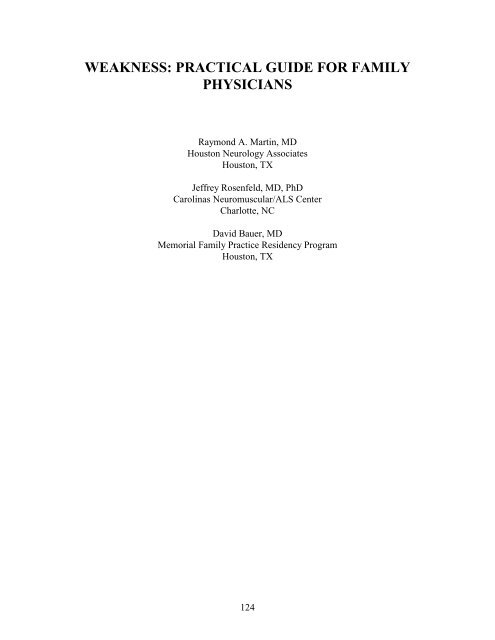
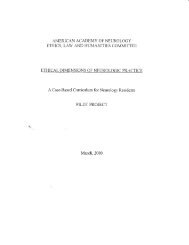


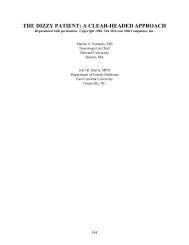

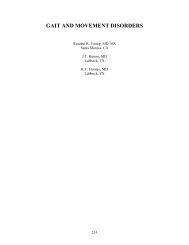
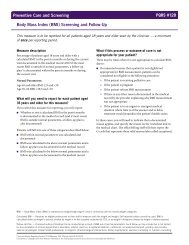
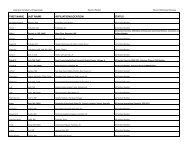
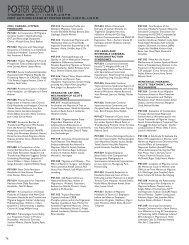
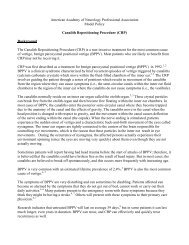
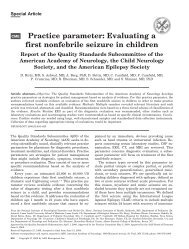
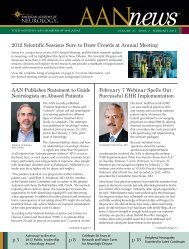
![[Click here and type date] - American Academy of Neurology](https://img.yumpu.com/8582972/1/190x245/click-here-and-type-date-american-academy-of-neurology.jpg?quality=85)
